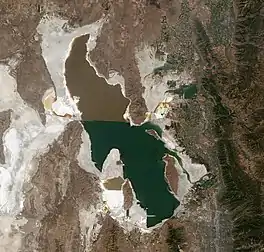
A halosere is an ecological succession in a saline water saline environments. An example of a halosere is a salt marsh.
In a river estuary, large amounts of silt are deposited by the ebbing tides, as well as inflowing rivers.
Plants in halosere

The earliest plant colonizers are algae and zostera, which can tolerate submergence by the tide for most of the 12 hour cycle and which trap mud, causing it to accumulate.
Two other colonizer plants are Salicornia, and Spartina, which are both halophytes. Halophytes are plants that can tolerate saline conditions and they grow on the intertidal mudflats with a maximum of four hours' exposure to air every 12 hours. On a large scale halophytes have colonized the halosere on the banks of the Great Salt Lake in Utah.[1] Halosere vegetation can also be found in the salt marshes of the Wadden Sea islands and the zone towards the dunes.[2]
River estuaries
In a river estuary, large amount of silt are depositing. Halosere in river estuaries consist of mudflats and the so called sward zone. Halosere sward zones can be found in the Llanrhidian marsh on the Gower Peninsula.[3]
See also
References
- ↑ C.B. Osmond; O. Björkman; D.J. Anderson (2012). Physiological Processes in Plant Ecology: Toward a Synthesis with Atriplex. Springer Berlin Heidelberg. p. 119. ISBN 9783642676376.
- ↑ Dietrich Mossakowski; Ulrich Irmler, eds. (2023). Terrestrial Coastal Ecosystems in Germany and Climate Change. Springer International Publishing. p. 96. ISBN 9783031125393.
- ↑ David Waugh (2000). Geography: An Integrated Approach. Nelson. p. 291. ISBN 9780174447061.